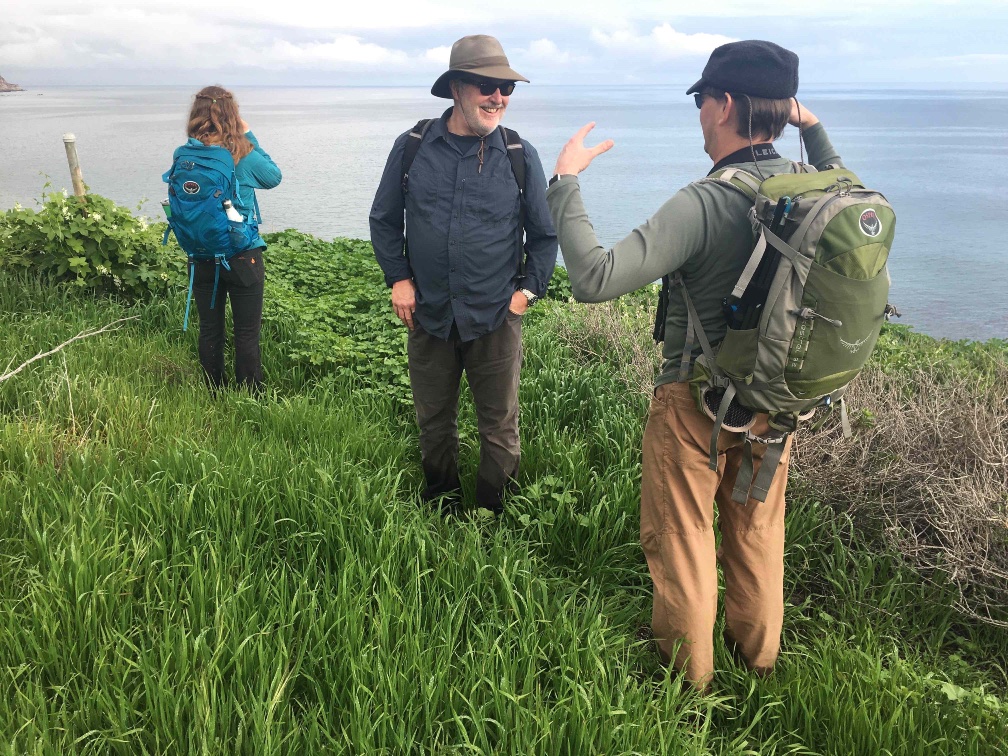Meet an Alum: Steve Monfort
May 1, 2023

Steve Monfort (center) and colleagues at Santa Cruz Island Reserve
Five Questions for Biological Sciences Alum Steve Monfort (bachelor's degree, '80)
What do you do?
I am the executive director of the University of California Natural Reserve System (UC NRS)—the world’s largest university-managed network of natural areas. UC’s 41 field stations (47,000 acres of land) represent all major ecosystems of California, from coastal tidepools to inland deserts, and lush wetlands to redwood forests. These reserves enable the UC NRS to achieve its mission of contributing to the understanding and wise stewardship of the Earth and its natural systems by supporting university-level teaching, research and public service at protected natural areas throughout California.
Why do you do what you do?
I have deep appreciation for the natural world, and I am passionate about using science to understand and sustain nature. With climate change and the associated losses of biological diversity, it is not an exaggeration to say that it’s “code red for humanity.” The loss of critical species of plants and animals means that ecosystems are losing their ability to provision humankind with “nature’s benefits,” including clean air, water and food.
What have you done?
After obtaining my undergraduate degree at UC San Diego, I earned a master’s degree in physiology and a veterinary degree from UC Davis, before moving to Washington DC to pursue a PhD studying the reproductive biology of endangered species. What was supposed to be a 5-year detour to earn a doctorate before moving back to California became a 35-year career that culminated with serving as director of the Smithsonian’ National Zoo and Conservation Biology Institute. There I led a large conservation science team that worked to understand and sustain species and ecosystems in more than 30 countries worldwide, as well as in the USA. I developed a particular interest in the Sahara Desert, and amongst my proudest achievements was helping to lead a major international effort to successfully reintroduce the previously “extinct in the wild” scimitar-horned oryx back into the Sahelian grasslands of Chad in 2017. In my first year as UC NRS executive director, I visited all 41 reserves to see for myself the amazing ecological diversity of our state, and to meet in-person with our incredible campus-based UC NRS teams. As UC NRS executive director, I am seeking to harness the incredible physical and intellectual assets of the UC to better understand how we can ensure a more sustainable and resilient planet for current and future generations.
Why is the UC Natural Reserve System so important?
The most threatened biological diversity in the U.S. is in California. Fortunately, we are seeing a convergence of climate change and biodiversity agendas, and an increasing recognition of the importance of land stewardship, ecosystem conservation and restoration in developing nature-based solutions to climate change. The scale and complexity of the environmental problems we face challenge us to think bigger, and to develop more effective partnerships to address problems at and appropriate scale needed to achieve significant impact. The UC NRS is perfectly positioned to coalesce UC’s incredible systemwide assets to achieve meaningful impact at scale.

Breezy Jackson, director of the Yosemite Field Station in the UC Natural Reserve System, and Steve Monfort at the Yosemite Valley overlook
Jessica Malisch
A ground-breaking event was recently held at the NRS’s Kendall-Frost Mission Bay Marsh Reserve for a new Field Station and Learning Center. How do you think the new facility will change the education and outreach capabilities at the reserve?
The Learning Center will provide an amazing opportunity for students to engage in hands-on activities, and to fall in love with nature’s wonders, not in some far away land, but in their own city. I have no doubt that programs held there will light a fire in an army of young people who will work tirelessly to secure a better future for Mission Bay, and for all the citizens that depend on the benefits that wetlands provide.
What were key takeaways from your education at UC San Diego’s School of Biological Sciences?
I found college rather daunting and intimidating, but the game changer for me came in the form of a UC San Diego mentor, Dr. Bill Lasley, who ran the wildlife endocrinology lab at the San Diego Zoo. During my internship, Bill’s mentorship and belief in my potential opened a whole new world to me and gave me the confidence to pursue a research career. Ever since, I have endeavoured to pay that investment forward by mentoring students and creating pathways for young people to find their way to achieving their dreams through science and discovery, as Bill did for me.
What have you learned since?
The world is full of well-meaning people who will tell you what you cannot do, mostly based on their own perceptions related to the risk of failure! As a scientist, I have learned that failure is an opportunity for improvement and almost always an essential precursor to ultimate success. I learned that resilience and persistence are key elements for one’s success. I’ve also learned that that no matter how hard I work, the environmental problems I’ve been working to address will not be solved in my own lifetime. This has reinforced for me the critical importance of building knowledge bridges between successive generations so that there’s continuity in the work we’re doing to find solutions to existential environmental challenges.
